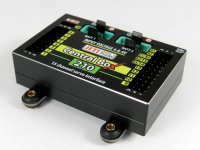1) The delay between each PPM frame is not always constant. The minimum synchronisation gap between frames is 4 milliseconds but it can be longer because the receiver has to wait for new data from the transmitter. If you want a constant frame rate you should set an appropriate number of output channels that will fit into this time period.
Example: The flybarless system requires a constant PPM output period of 20ms. You need to consider that each channel might take up to 2.0 miliseconds. The minimum inter-frame gap is 4ms. The resulting equation can be expressed as follows:
20ms = (2.0ms · N) + 4ms
N = (20ms - 4ms) / 2.0ms = 8 channels
2) When PPM positive or negative output mode is selected (setting is available in the Device Explorer screen), PPM input from the satellite (Sat1 input) is not used. The receiver does not generate any additional servo signals and it only generates PPM on a single output pin. This mode is suitable only for small receivers or satellites Rsat2 where you need all channels on a single line.
3) When a receiver is in Servo mode, it is possible to have a non-standard PPM output through the Sat2 output setting. In this case the channel count is 16 channels fixed (for DC/DS transmitters (*)), polarity is positive and fixed and the frame rate is reduced to about 30 Hz. This mode is designed to connect multiple JETI receivers together to reach redundancy if one of the receiver loses wireless signal. In such a case the decreased output period is a sufficient solution - you still have all the channels available.
(*) The number of output channels depends on number of transmitter channels.



















